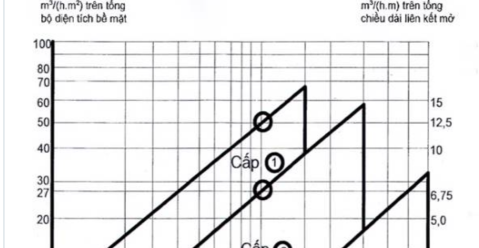Determination of the air permeability of windows and doors according to national standards in Vietnam

Hello, Lawnet would like to answer as follows:
1. What is air permeability? Principles, equipment, and tools for air leakage testing in Vietnam
Standard TCVN 7452-1:2021 stipulates as follows:
Air permeability is the amount of air that passes through a closed and tightly installed door sample under the influence of test pressure. Air leakage is calculated in cubic meters per hour (m3/h).
Principles of testing
Apply a specified test pressure range (positive pressure and negative pressure), and at each test pressure value, use appropriate testing equipment to measure air leakage.

Air leakage testing equipment and tools
- The test chamber has one side open to install the test sample. This chamber is constructed so that it can withstand the test pressure without deforming or affecting the test results.
- Pressure regulator to control the test pressure for the test sample.
- Pressure transducer to create rapid changes in test pressure while being controlled within defined limits.
- Flowmeter to measure air flow into or out of the test chamber with an accuracy of ± 5 % (calibrated at +20 °C, 101 kPa).
- Pressure measuring device to measure the test pressure applied to the test sample, with an accuracy of ± 5 %.
- Means of sealing connections to the sample, if necessary.
2. How to determine the air permeability of windows and doors
Standard TCVN 7452-1:2021 stipulates how to proceed as follows:
- General requirements
+ The ambient temperature and humidity around the test sample is from 10 °C to 30 °C and the relative humidity (RH) is from 25 % to 75 %; the sample is cured under the above conditions for at least 4 hours immediately before testing.
+ Temperature is measured with an error of ± 3 °C and relative humidity is measured with an error of ± 5 %. Air pressure is measured with an error of ± 1 kPa.
+ The test pressure gradually increases in the following steps by 50 Pa more than the previous step until reaching 300 Pa. From 300 Pa or more, an increase of 150 Pa is applied.
+ Determine air leakage accuracy to 10%.
- Air leakage in the test chamber
The determination of the test procedure to be applied depends on the specified level of air leakage in the test chamber.
- The test chamber has a known air leakage level
+ If the known air permeability is less than 5% of the maximum allowable air permeability over the entire applicable classification range, the air permeability of the test chamber is considered zero.
+ When this condition is not guaranteed, measure the air leakage of the test chamber as specified in Section 8.2.2 of Standard TCVN 7452-1:2021, unless the air permeability is known and the air permeability is approximately constant within the accuracy of laboratory measurements.
+ Do not allow the test chamber to have air permeability exceeding 30% of the total air permeability of the test sample and the test chamber.
- The test chamber has unknown air leakage
+ Use adhesive tape (covering sheet) to seal all connections of the test sample or use a sealing sheet to cover the entire test sample. Measure the air leakage of the test chamber using positive test pressure as prescribed in section 8.3.1 of Standard TCVN 7452-1:2021. Measure the air leakage of the test chamber using negative test pressure as specified in Section 8.3.1 of Standard TCVN 7452-1:2021 when necessary.
+ Remove the tape or sheet covering the test sample.
- Measure the total air leakage of the test sample and the test chamber with positive pressure
+ Open and close all openings of the test specimen at least once before locking them in the closed position.
+ Measure the air permeability of the test sample using positive test pressure as specified in 8.3.1; test procedures refer to Appendix A.
- Measure air leakage
Conduct 3 pressure pulses, each 10% greater than the maximum test pressure applied in the test or 500 Pa, whichever is greater. The time for the pressure to reach its maximum value is not less than 1 s, and this pressure is maintained for at least 3 s. Carry out the positive pressure test steps as specified in Section 8.1 of Standard TCVN 7452-1:2021. Measure and record air leakage at each step. The time for each step must be sufficient for the test pressure to stabilize before measuring air leakage.
- Measure the total air leakage of the test sample and the negative pressure test chamber
Only perform this test when required. Open and close all openings of the test specimen at least once before securing them in the closed position. Measure the air permeability of the test sample and test chamber using negative pressure as specified in Section 8.3.1 of Standard TCVN 7452-1:2021; Testing procedures refer to Appendix A issued with Standard TCVN 7452-1:2021.
Best regards!
Please Login to be able to download





